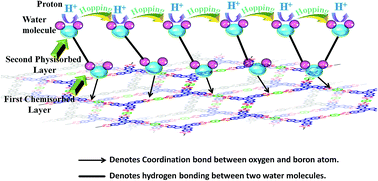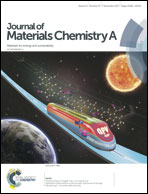A porous, crystalline truxene-based covalent organic framework and its application in humidity sensing†
Abstract
Truxene is employed as a building block to successfully synthesize novel covalent organic frameworks (COFs). The condensation reaction between truxene (10,15-dihydro-5H-diindeno[1,2-a:1′,2′-c]fluorene, TX) and 1,4-phenylenediboronic acid (DBA) results in a crystalline COF with boron ester linkages (COF-TXDBA) and a surface area of 1526 m2 g−1, as confirmed by powder X-ray diffraction (PXRD) and Brunauer–Emmett–Teller (BET) surface area measurements. This is the first study where nanochannels generated by periodic COF planar layers are shown to ease the interactions of the boron ester linkages with the water molecules for efficient humidity sensing. The COF-TXDBA based % RH sensor exhibits a change of 3 orders of magnitude in impedance in the 11–98% RH range, with response and recovery times of 37 s and 42 s, respectively. The response transients measured by switching COF-TXDBA sensor back and forth in 4 loops of % RH range displays excellent reversibility of the sensor with a deviation of 2.3% in the switching process.



 Please wait while we load your content...
Please wait while we load your content...